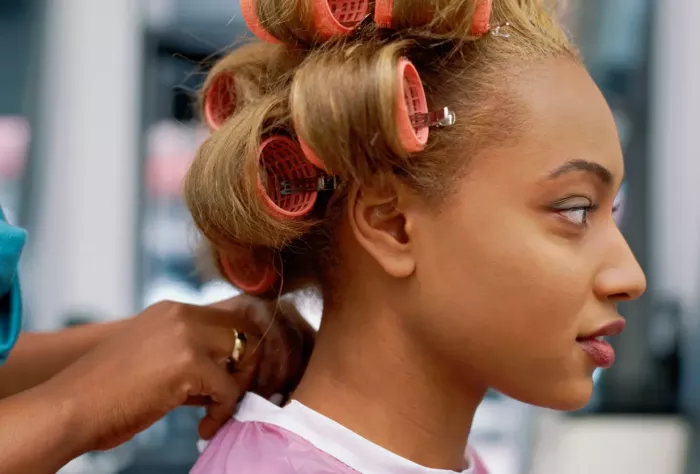Dry hair can be a persistent issue, especially if your strands are naturally prone to dehydration. The key to maintaining healthy, moisturized hair is consistent care, using the right products, and adopting good hair habits. Dry hair isn’t just a nuisance; it can lead to breakage, split ends, frizz, and tangling. However, with the right techniques, you can keep your hair vibrant, elastic, and shiny. Here’s how to give your hair the moisture it craves:
1. Focus on Lightweight Hydration First
Before jumping to heavy-duty products like deep conditioners or oils, start by introducing water-based products into your routine. Celebrity stylist Marquita Lynch explains, “You can’t lock in moisture that isn’t there, so it’s important to use products that draw moisture into your hair.” Look for leave-in conditioners or hair mists that use water as their main ingredient. These help hydrate your hair from within, setting the foundation for long-lasting moisture.
2. Lock in Moisture with Oils and Creams
Once your hair is hydrated, the next step is to lock that moisture in. Use oils or creams to seal the hair cuticle and prevent moisture from escaping. Clyde Haygood, a celebrity hairstylist, advises choosing the right oil based on your hair type. “Fine hair needs lighter oils that won’t weigh it down, while coarse hair benefits from heavier oils,” he says. Coconut oil, argan oil, or jojoba oil can be great options, but it’s important to experiment and find what works best for your hair.
3. Deep Condition Weekly
For a moisture boost, a weekly deep conditioning treatment is essential. This step provides your hair with an intensive dose of hydration. Rogerio Cavalcante, owner of The Second Floor Salon, recommends leaving a deep conditioner on for 10 to 15 minutes to see the best results. For an even deeper treatment, try applying heat while conditioning—this helps the product penetrate the hair shaft more effectively. A heat cap, hooded dryer, or even a warm towel can be used to achieve this effect.
4. Consider Co-Washing
Shampooing too frequently can strip your hair of its natural oils, exacerbating dryness. To combat this, consider co-washing—washing your hair with conditioner instead of shampoo. Cavalcante suggests co-washing as an alternative for those who need to cleanse their hair often, as it helps retain natural oils and prevents hair from becoming overly dry. Co-washing can be particularly helpful for curly, textured hair, which tends to be drier than other hair types.
5. Use Moisturizing Dry Shampoos
If you need to freshen up your hair between washes, try a moisturizing dry shampoo. These products absorb excess oil while also providing hydration. Cavalcante notes that there are now dry shampoos available with nourishing ingredients that won’t dry out your hair, making them a great option for maintaining moisture between washes.
6. Blow Dry with Ionic Technology
Blow drying can be damaging to your hair, but avoiding it altogether isn’t always realistic. Instead, invest in an ionic hair dryer, which releases negative ions that break down water molecules on your hair, speeding up the drying process and reducing frizz. Dr. Kseniya Kobets, a board-certified dermatologist, recommends ionic dryers because they minimize damage compared to traditional dryers, helping keep your hair healthier and shinier.
7. Use Ceramic or Tourmaline-Plated Irons
When heat styling your hair, using the right tools is crucial. Curling and flat irons with ceramic or tourmaline plates distribute heat evenly and allow your hair to glide smoothly over the surface. This reduces hot spots and tugging, which can cause breakage. Moreover, these tools can help lock in moisture, leaving your hair with a shinier, smoother finish.
8. Protect Your Hair at Night
Your nighttime routine is just as important as your daytime care when it comes to moisture retention. Lynch advises wrapping your hair in a satin scarf or sleeping on a satin pillowcase. Cotton pillowcases can absorb moisture from your hair, leading to dryness. Satin materials, on the other hand, allow your hair to retain its natural oils. Additionally, applying a light mist of water and a few drops of sealing oil before bed can help maintain moisture while you sleep.
9. Apply Scalp Treatments at the Root
For those dealing with dandruff or an itchy scalp, it’s important to focus treatments directly at the root. Dr. Kobets explains that products like shampoos containing salicylic acid or ketoconazole should be applied primarily to the scalp, as they can dry out the hair if extended too far down the strands. Always follow the instructions on the product or as advised by your dermatologist to ensure you’re treating your scalp effectively without compromising your hair’s moisture.
Conclusion
Keeping dry hair moisturized requires a mix of the right products, consistency, and smart habits. Start by incorporating lightweight hydration into your routine, then lock it in with oils and creams. Deep conditioning treatments, co-washing, and using moisturizing dry shampoos can further boost moisture. Heat styling should be done carefully with ionic dryers and high-quality irons to prevent damage. Lastly, protecting your hair at night and applying scalp treatments correctly can ensure long-term health and moisture retention.
With these tips in mind, you can maintain hydrated, vibrant hair that looks and feels its best—even if it’s naturally prone to dryness.


